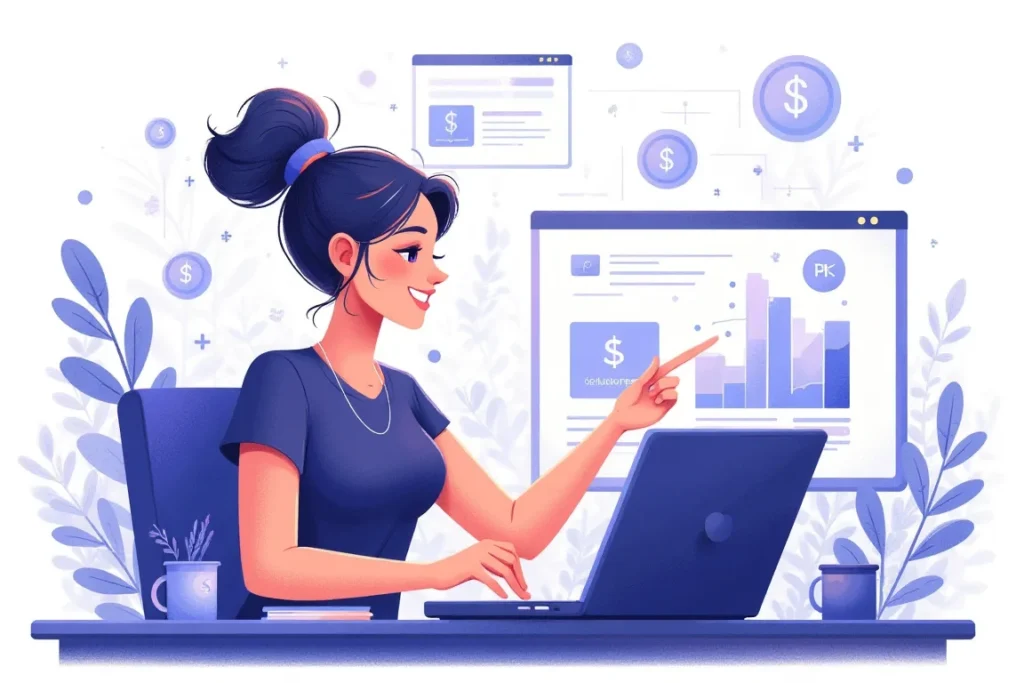Want to turn a $7 PLR purchase into a $47 premium product that sells like hotcakes? The secret isn’t just slapping your logo on generic content and calling it a day. Smart entrepreneurs who understand how to rebrand PLR digital products effectively to resell are quietly building profitable businesses while others struggle with original content creation. They’ve cracked the code on transforming ready-made content into irresistible, branded products that customers eagerly buy. And today, I’m sharing exactly how they do it.
Key Takeaways
Learning how to rebrand PLR digital products for resell to get high profit starts with understanding that customization is everything. You can’t just slap your name on generic content and expect premium results. Here’s what you need to know:
- Complete brand transformation – Change titles, covers, colors, fonts, and design elements to match your unique brand identity
- Content enhancement – Rewrite sections, add personal insights, update statistics, and include current examples to increase value
- Strategic positioning – Target specific niches and customer pain points rather than trying to appeal to everyone
- Multiple format creation – Transform one PLR product into ebooks, courses, workbooks, email series, and social media content
- Premium pricing strategy – Focus on value-added customization that justifies higher price points than generic PLR
Want to skip the lengthy customization process and start selling immediately? Consider exploring Ready-to-Sell Digital Products on plrbizhub.com. These products come professionally designed and optimized for multiple platforms, letting you launch your business today instead of spending weeks on rebranding.
Understanding PLR Digital Products And Rebranding Basics
PLR digital products are pre-made content that you can legally modify, brand, and sell as your own. Think of them as the foundation for your digital empire rather than finished products. The biggest mistake I see people make is treating PLR like a shortcut to instant profits without putting in the customization work.
When you understand how to rebrand PLR digital products effectively to resell, you’re essentially learning how to take raw materials and create premium offerings. This isn’t about changing a few colors and calling it done. It’s about strategic transformation that adds genuine value.
The rebranding process involves several key elements: visual redesign, content enhancement, format transformation, and strategic positioning. Each element plays a crucial role in differentiating your products from the sea of generic PLR floating around online.
Most successful PLR entrepreneurs follow a systematic approach. They start by analyzing the original content for strengths and weaknesses, then develop a customization plan that aligns with their brand and target market. This methodical approach ensures that every change serves a purpose and contributes to the overall value proposition.
Why Generic PLR Fails In The Marketplace
Generic PLR fails because it lacks personality, relevance, and uniqueness. When hundreds of people are selling identical products, the only differentiator becomes price, creating a destructive race to the bottom.
Customers today are sophisticated. They can spot recycled content instantly, and they’re willing to pay more for products that feel personalized and valuable. This is exactly why learning how to rebrand PLR digital products effectively to resell is so crucial for long-term success.
The marketplace rewards authenticity and value. Products that clearly show customization, personal branding, and enhanced content consistently outperform their generic counterparts. This creates an opportunity for entrepreneurs who understand the rebranding process.
The Legal Framework Of PLR Usage
Before diving into rebranding techniques, you need to understand PLR licensing terms. Most PLR licenses allow modification, rebranding, and resale, but some have restrictions on specific uses or distribution methods.
Always read the license agreement carefully. Some PLR products prohibit certain modifications or have requirements about maintaining original credits. Understanding these limitations helps you plan your rebranding strategy effectively.
The beauty of proper PLR licensing is the freedom it provides. Unlike copyrighted material, PLR gives you the legal right to transform content completely, making it genuinely yours through customization and enhancement.
Useful Articles:
Step-By-Step Process To Transform Your PLR Products
The transformation process begins with thorough analysis of your source material. I always start by reading through the entire PLR package to understand its structure, strengths, and areas needing improvement.
Content audit comes first. Make notes about outdated information, weak sections, missing elements, and opportunities for enhancement. This audit becomes your roadmap for the entire rebranding process.
Next, define your target market and brand positioning. Your rebranding decisions should align with your audience’s preferences, pain points, and expectations. This strategic focus ensures that every modification serves your business goals.
Visual Rebranding Techniques
Visual transformation is often the most dramatic aspect of PLR rebranding. Start with the cover or main visual elements, as these create the first impression potential customers will have.
Professional design tools like Canva make visual rebranding accessible even if you’re not a designer. Focus on colors, fonts, imagery, and layout that reflect your brand personality. Consistency across all visual elements creates a cohesive, professional appearance.
Don’t underestimate the power of custom graphics and images. Replacing stock photos with images that resonate with your specific audience can dramatically improve engagement and conversion rates.
Content Enhancement Strategies
Content enhancement goes far beyond simple text replacement. Start by rewriting introductions and conclusions to match your brand voice, then work through the main content systematically.
Add personal insights, current examples, and relevant statistics to increase the value proposition. Your goal is to make the content feel fresh, relevant, and uniquely yours. This might involve restructuring sections, adding new chapters, or creating supplementary materials.
Update any outdated information, broken links, or obsolete references. Customers notice these details, and attention to accuracy builds credibility and trust in your brand.
Advanced Customization Methods For Higher Profits
Advanced customization involves transforming single PLR products into multiple revenue streams. One ebook can become a video course, email series, workbook, social media content, and podcast episodes.
Format transformation multiplies your investment return. Instead of selling one $27 ebook, you can create a $197 comprehensive package that includes multiple formats and bonus materials. This approach significantly increases your profit potential.
Consider your audience’s learning preferences and consumption habits. Some people prefer video content, others want written materials, and many appreciate having multiple formats available. Catering to these preferences through format diversity creates broader market appeal.
Creating Premium Product Bundles
Bundle creation is where rebranding becomes truly profitable. Combine related PLR products, add custom bonuses, and position the bundle as a comprehensive solution to specific problems.
Effective bundles solve complete customer journeys rather than addressing isolated issues. For example, a weight loss bundle might include meal planning guides, workout routines, mindset materials, and tracking tools. This comprehensive approach justifies premium pricing.
The key to successful bundling is perceived value. Customers should feel they’re getting significantly more value than the individual component costs. Strategic packaging and presentation make this perception reality.
Developing Unique Value Propositions
Your value proposition differentiates your rebranded PLR from competitors using similar source materials. This involves identifying unique angles, targeting specific sub-niches, or adding exclusive elements that others can’t replicate.
Personal experience and expertise become your competitive advantage. Even if multiple people rebrand the same PLR, your unique perspective and additional insights create genuine differentiation. This is particularly powerful in expertise-based markets.
Consider creating exclusive bonuses that complement the main PLR content. These might include templates, checklists, video tutorials, or access to private communities. These additions justify higher prices and increase customer satisfaction.
Useful Articles:
Maximizing Resale Value Through Strategic Positioning
Strategic positioning involves choosing the right market segments and pricing strategies for your rebranded PLR products. This decision significantly impacts your profit potential and long-term success.
Market research informs positioning decisions. Look at competing products, price points, customer reviews, and market gaps. This information helps you identify opportunities for premium positioning or underserved market segments.
Positioning isn’t just about price; it’s about perception. Premium positioning requires premium presentation, enhanced content, and superior customer experience. This holistic approach supports higher prices and better profit margins.
Platform-Specific Optimization
Different sales platforms have unique requirements and audience expectations. What works on Etsy might not work on your own website, and Amazon KDP has different considerations than ClickBank.
Optimize your rebranded PLR for each platform’s specific requirements. This might involve adjusting formats, descriptions, keywords, or pricing strategies. Platform optimization maximizes visibility and conversion rates.
Consider the customer journey on each platform. Some platforms favor impulse purchases, while others support more considered buying decisions. Your presentation and positioning should align with these platform characteristics.
Building Long-Term Customer Relationships
Rebranded PLR products should be stepping stones to larger customer relationships rather than one-time transactions. This perspective changes how you approach customization and customer interaction.
Include elements that encourage ongoing engagement. This might involve creating email sequences, offering related products, or building communities around your brand. These strategies increase lifetime customer value significantly.
Quality rebranding builds trust and credibility that supports future sales. Customers who have positive experiences with your rebranded PLR are more likely to purchase additional products and recommend your brand to others.
Common Mistakes That Kill PLR Profits
The biggest mistake is minimal customization. Simply changing the title and adding your logo doesn’t create meaningful differentiation or justify premium pricing. This approach leads to price competition and reduced profits.
Another critical error is ignoring your target market’s specific needs and preferences. Generic rebranding that doesn’t address particular audience segments fails to create strong market appeal. Your customization should feel targeted and relevant.
Poor quality control during the rebranding process damages your brand reputation. Spelling errors, broken formatting, outdated information, or inconsistent branding elements create negative customer experiences that hurt long-term success.
Technical Implementation Problems
Technical issues during rebranding can create significant problems. These include formatting errors when converting between file types, broken links in digital products, or compatibility issues across different devices or platforms.
Test your rebranded products thoroughly before launch. This includes checking all links, ensuring proper formatting across different viewing methods, and verifying that interactive elements work correctly. Quality control prevents customer complaints and refund requests.
File organization and naming conventions matter more than most people realize. Professional file structures make your products feel polished and legitimate, while poor organization creates confusion and reduces perceived value.
Useful Articles:
Tools And Resources For Efficient Rebranding
Modern rebranding relies heavily on accessible tools that streamline the customization process. Canva leads the visual design space, offering templates and elements that make professional-looking designs achievable for non-designers.
Content enhancement tools like ChatGPT or Grammarly help improve writing quality and generate fresh content ideas. These AI-powered tools can suggest improvements, help rewrite sections, and ensure professional presentation quality.
File conversion tools, image editors, and PDF creators complete the technical toolkit needed for comprehensive PLR rebranding. Many of these tools offer free versions that provide sufficient functionality for most rebranding projects.
Automation Strategies
Automation reduces the time investment required for PLR rebranding while maintaining quality standards. This might involve creating templates for consistent branding, developing checklists for quality control, or using batch processing for repetitive tasks.
Systematic approaches to rebranding create efficiencies that compound over time. The more you refine your process, the faster you can transform PLR products into market-ready offerings. This efficiency directly impacts profitability.
Consider creating style guides and brand standards that streamline decision-making during rebranding. When you have predetermined fonts, colors, and design elements, customization becomes faster and more consistent.
Understanding how to rebrand PLR digital products effectively to resell opens doors to profitable business opportunities that most entrepreneurs never discover. The key lies in viewing PLR as raw material for creating premium, branded experiences rather than shortcuts to quick money. With systematic customization, strategic positioning, and attention to quality, your rebranded PLR products can command premium prices while building lasting customer relationships.




